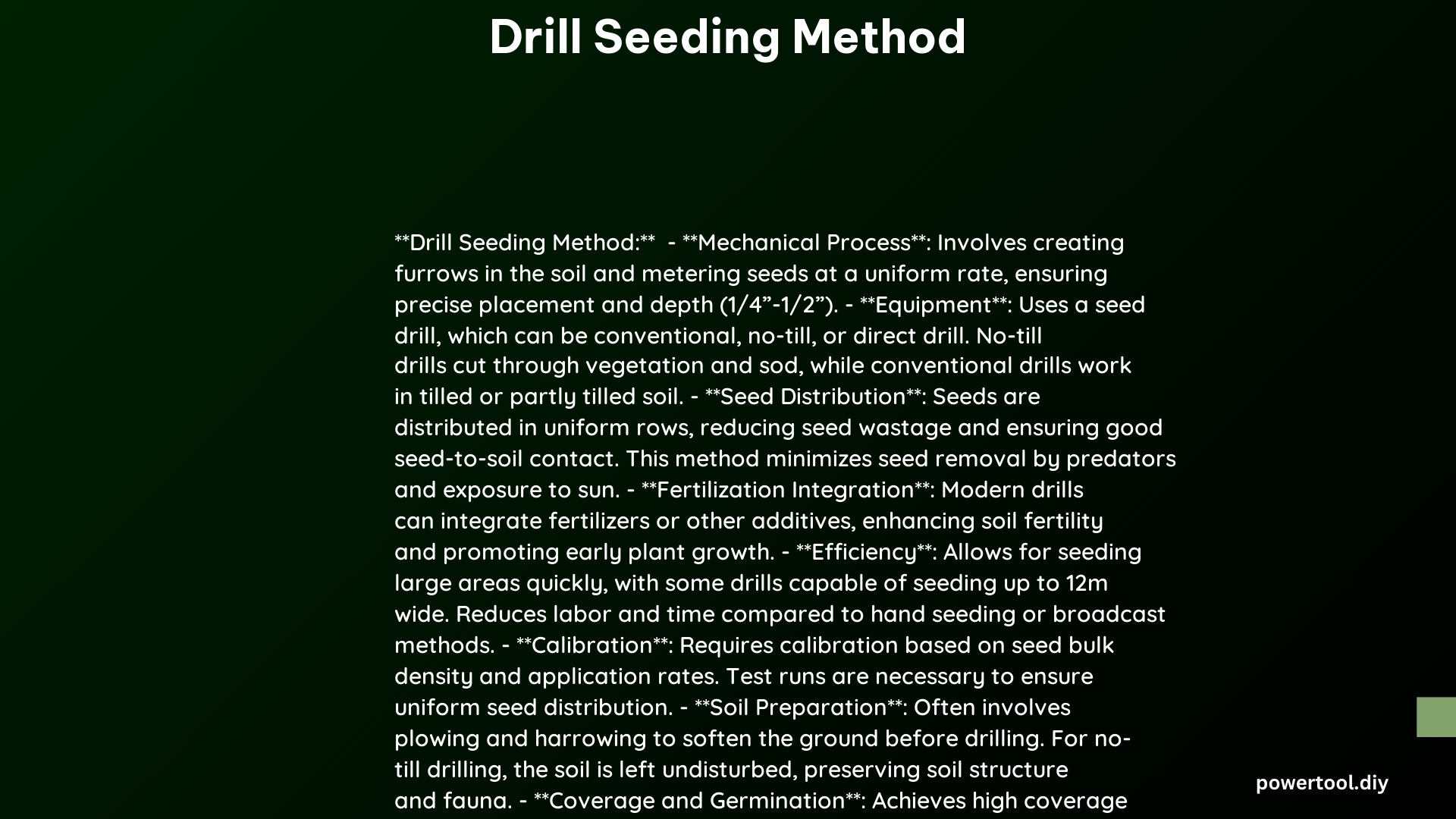Drill seeding is a precise and efficient agricultural technique for planting seeds. This method uses specialized machinery to create furrows, deposit seeds at consistent depths and intervals, and cover them with soil. Drill seeding offers numerous advantages, including improved seed-to-soil contact, uniform seed distribution, and reduced soil disturbance. It’s particularly effective for large-scale farming operations and conservation efforts, enhancing crop establishment and yield potential.
What is Drill Seeding?
Drill seeding is a mechanized planting method that utilizes a seed drill to sow seeds directly into the soil. This technique offers precise control over seed placement, depth, and spacing, making it an efficient and effective way to establish crops or restore vegetation. The drill seeder creates narrow furrows, deposits seeds at predetermined intervals, and then covers them with soil, all in one pass.
What Are the Key Benefits of Drill Seeding?

-
Improved Seed-to-Soil Contact: Drill seeding ensures better seed-to-soil contact, which is crucial for germination and early seedling growth.
-
Uniform Seed Distribution: The method provides consistent seed spacing and depth, leading to more uniform crop stands.
-
Reduced Soil Disturbance: Compared to broadcast seeding or traditional tillage methods, drill seeding minimizes soil disturbance, helping to preserve soil structure and reduce erosion.
-
Efficient Use of Seeds: Precise placement reduces seed waste, potentially lowering input costs.
-
Time and Labor Savings: Drill seeding combines multiple operations (soil preparation, seeding, and covering) into one pass, saving time and labor.
-
Moisture Conservation: By placing seeds directly into the soil, this method helps conserve moisture, which is particularly beneficial in drier regions.
-
Weed Suppression: Uniform crop stands established through drill seeding can better compete with weeds.
-
Reduced Environmental Impact: Less soil disturbance means lower greenhouse gas emissions and better preservation of soil ecosystems.
How Does Drill Seeding Work?
The drill seeding process involves several key components and steps:
-
Seed Hopper: Seeds are loaded into a hopper on the drill seeder.
-
Furrow Openers: As the machine moves, furrow openers (often disc-shaped) create narrow trenches in the soil.
-
Seed Metering: A metering system precisely controls the rate at which seeds are released from the hopper.
-
Seed Tubes: Seeds travel through tubes from the hopper to the furrows.
-
Seed Placement: Seeds are deposited into the furrows at a consistent depth and spacing.
-
Covering: Press wheels or drag chains cover the seeds with soil and gently firm the seedbed.
What Types of Drill Seeders Are Available?
There are several types of drill seeders, each designed for specific conditions or purposes:
-
Conventional Drill Seeders: Used in tilled or partially tilled soil.
-
No-Till Drill Seeders: Designed to plant directly into untilled soil with crop residue.
-
Air Seeders: Use air pressure to distribute seeds, often used for larger operations.
-
Precision Drill Seeders: Offer highly accurate seed placement for crops requiring precise spacing.
-
Grassland Drill Seeders: Specialized for seeding pastures and grasslands.
What Are the Best Practices for Drill Seeding?
To maximize the effectiveness of drill seeding, consider the following best practices:
- Proper Calibration: Ensure the seeder is correctly calibrated for the specific seed type and desired seeding rate.
- Soil Preparation: While drill seeding requires less soil preparation than some methods, ensure the seedbed is suitable for the crop and equipment.
- Timing: Choose the optimal planting time based on crop requirements and local climate conditions.
- Depth Control: Adjust seeding depth according to seed size and crop recommendations.
- Speed Management: Maintain a consistent, appropriate speed for even seed distribution.
- Regular Maintenance: Keep the drill seeder in good condition through regular cleaning and maintenance.
What Are the Technical Specifications for Drill Seeding?
| Parameter | Typical Range |
|---|---|
| Row Spacing | 6-12 inches |
| Seeding Depth | 0.25-2 inches |
| Operating Speed | 3-7 mph |
| Seeding Rate | Varies by crop |
| Hopper Capacity | 1-3 bushels per foot of width |
How Does Drill Seeding Compare to Other Seeding Methods?
Drill seeding offers several advantages over alternative seeding methods:
- Broadcast Seeding:
- Drill seeding provides better seed-to-soil contact and more uniform distribution.
-
Less seed waste compared to broadcast seeding.
-
Hand Seeding:
- Much faster and more efficient for large areas.
-
More consistent seed placement and coverage.
-
Hydroseeding:
- Better for dry conditions where water availability is limited.
- Often more cost-effective for large-scale operations.
What Are the Limitations of Drill Seeding?
While drill seeding offers many benefits, it’s important to consider its limitations:
- Equipment Cost: Initial investment in a drill seeder can be substantial.
- Terrain Restrictions: May not be suitable for very rocky or steeply sloped areas.
- Soil Moisture Requirements: Requires adequate soil moisture for optimal performance.
- Crop Residue Management: Heavy crop residues can interfere with seed placement in no-till systems.
- Skill Requirements: Proper operation and calibration require some expertise.
How Can Drill Seeding Contribute to Sustainable Agriculture?
Drill seeding aligns well with sustainable agriculture practices:
- Soil Conservation: Minimizes soil disturbance, reducing erosion and preserving soil structure.
- Water Efficiency: Improves water use efficiency by placing seeds at optimal depths.
- Reduced Inputs: Can lead to reduced use of herbicides and fertilizers due to better crop establishment.
- Carbon Sequestration: Less soil disturbance can help maintain soil organic carbon levels.
- Biodiversity: Can be used in conservation efforts to establish diverse plant communities.
By employing drill seeding methods, farmers and land managers can contribute to more sustainable and environmentally friendly agricultural practices while potentially improving crop yields and reducing input costs.
References:
1. AMTEC: 8 Benefits of Using Direct Drills for Seed Cultivation
2. Alpego Spa: Combined seed drill, benefits and applications
3. Ernst Conservation Seeds: Guide to Tools & Seeding Methods
